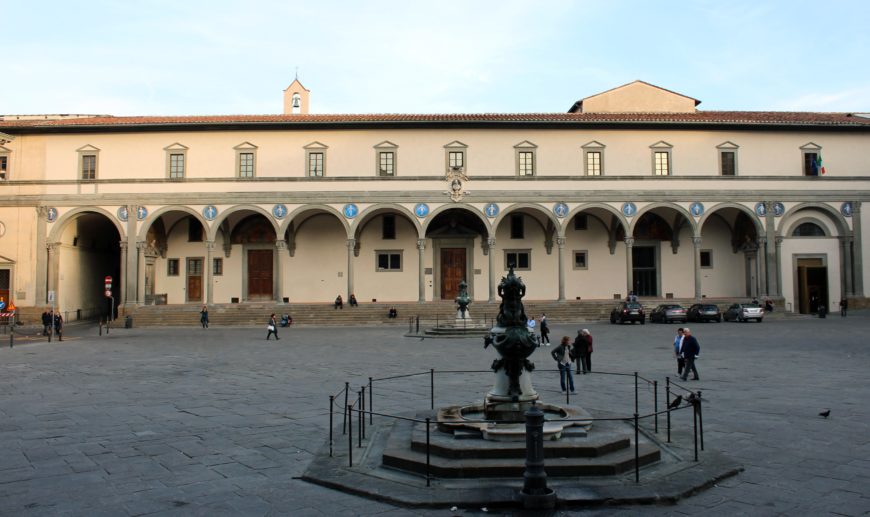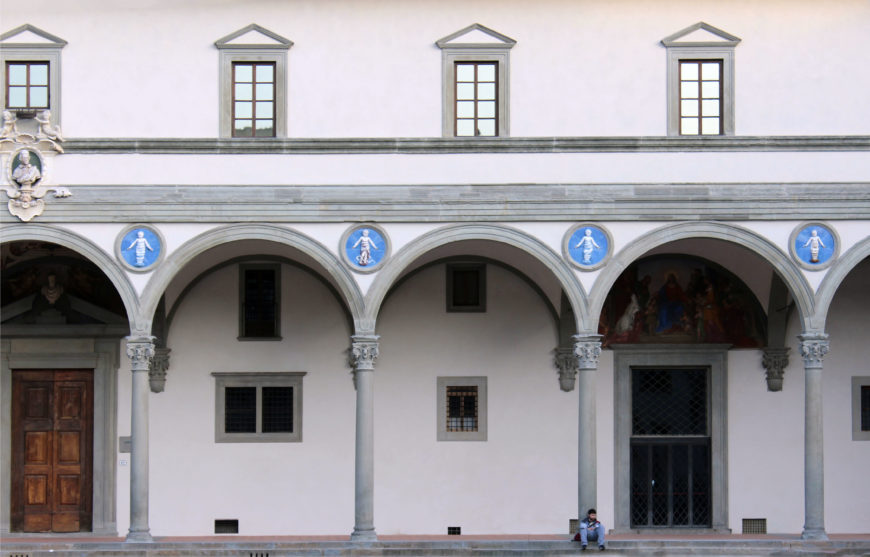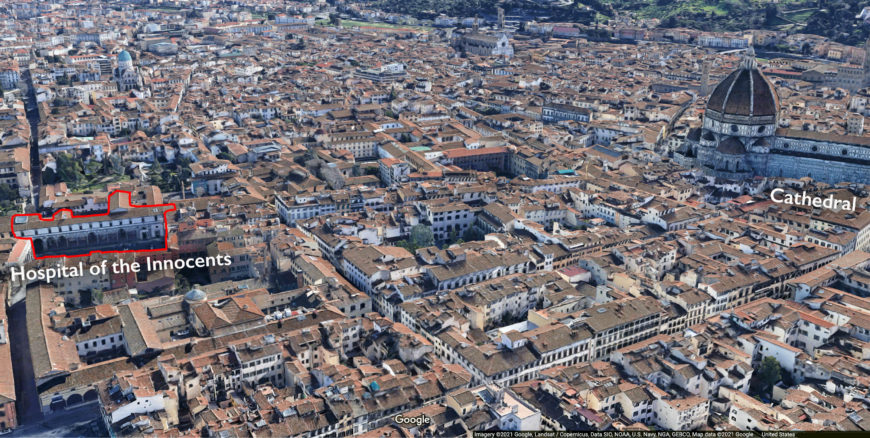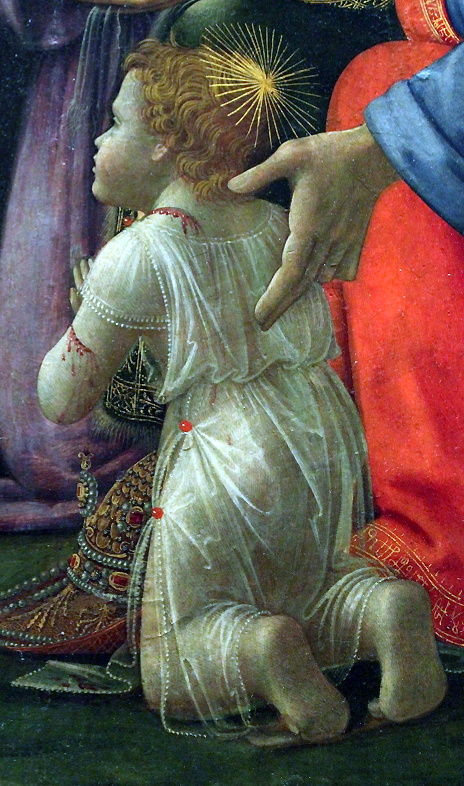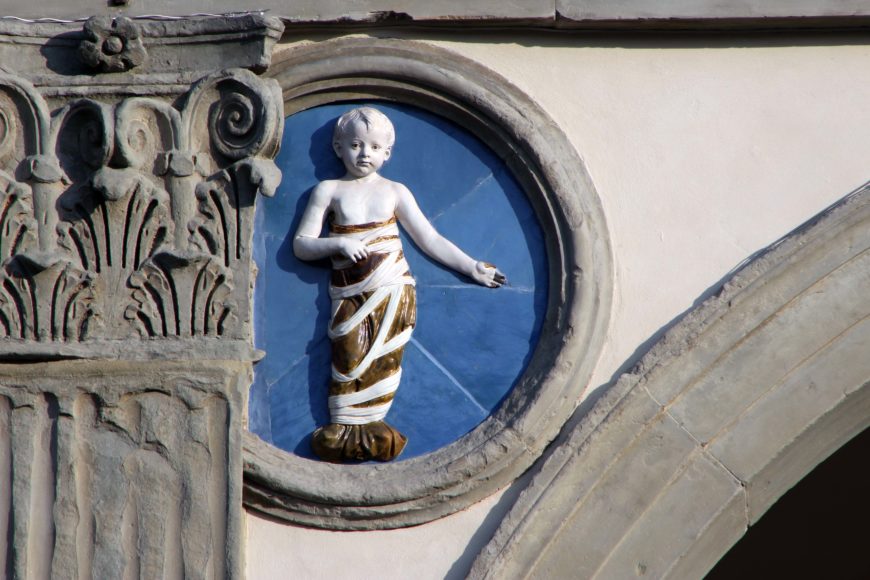
Andrea della Robbia, Infant in Swaddling Clothes, 1487, glazed terracotta, diameter about 100 cm, Ospedale degli Innocenti, Florence (photo: Rachel Boyd)
A sweet-faced youth gazes ahead demurely, his lips slightly parted, suggesting that he might be about to speak or smile. Grasping his loose swaddling bands with one hand, he stretches out his free arm, as if directing our attention to the entrance of the building beneath him.
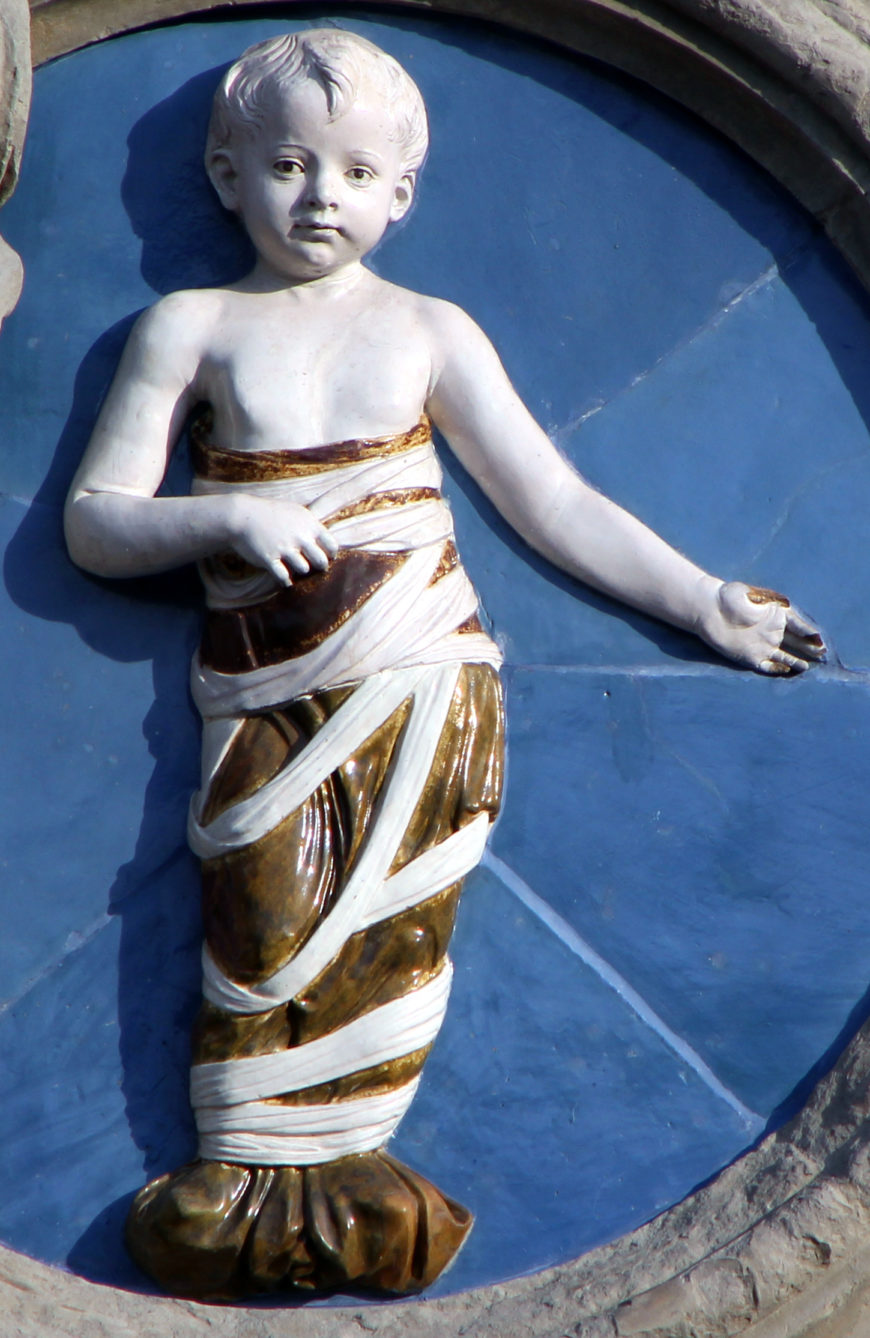
Andrea della Robbia, Infant in Swaddling Clothes, 1487, glazed terracotta, diameter about 100 cm, Ospedale degli Innocenti, Florence (photo: Rachel Boyd)
Created by Andrea della Robbia, this toddler is one of ten similar sculptures adorning the façade of the Ospedale degli Innocenti, a Florentine foundling hospital founded in 1419. The children appear at regular intervals between the bays of the loggia. Each one is set into a round (or nearly round) recess in the wall, inside a round frame of pietra serena, a grey stone quarried locally. The children themselves are made of another material characteristic of Renaissance Florence: glazed terracotta (more on this below).
Thanks to their shiny surfaces and sensitive modeling, the sculptures subtly change in appearance throughout the day. In this photograph, tiny pools of bright reflected light can be observed across the child’s body—in his hair, cheek, and breast, as well as the folds of the fabric around his hips and thighs. Where an artist working on a sheet of paper or a canvas might indicate the fall of light with touches of white, here the warm afternoon sun itself has created ephemeral gradations of color. The high relief of the child’s body, meanwhile, casts shadows on the flat blue ground behind him, emphasizing his real physical presence in our space.
Who were these children meant to represent? And why were they chosen to adorn this building?
Foundling care in Renaissance Florence
Today, we tend to think of hospitals as strictly medical facilities, but in the early modern world, their functions were much broader: these charitable organizations provided a range of physical and spiritual assistance—including food, clothing, and housing—to pilgrims, the poor, and the sick. Opened in 1445, the Innocenti was one of the first institutions in Europe dedicated specifically to the care of abandoned children.
The Innocenti took in infants whose parents could not raise them, whether because of death, illness, poverty, or another reason. The children were immediately recorded in a manuscript, and a scribe took notes regarding their health, any clothes or other belongings, and the identity of one or both parents, if known. Many foundlings were the children of enslaved people or servants who had been assaulted in the homes where they worked. More girls than boys were abandoned, probably in part because the necessity of providing a dowry for daughters put additional economic stress on a family. Leaving one’s child to the Innocenti was not necessarily a guarantee of help, however, since mortality rates at the hospital in the 1400s and subsequent centuries often exceeded 50 percent. While these rates are horrifying to modern eyes, the figures at the Innocenti were in fact low compared to similar institutions that developed elsewhere in Europe. [1]
Brunelleschi’s loggia and Andrea della Robbia’s roundels
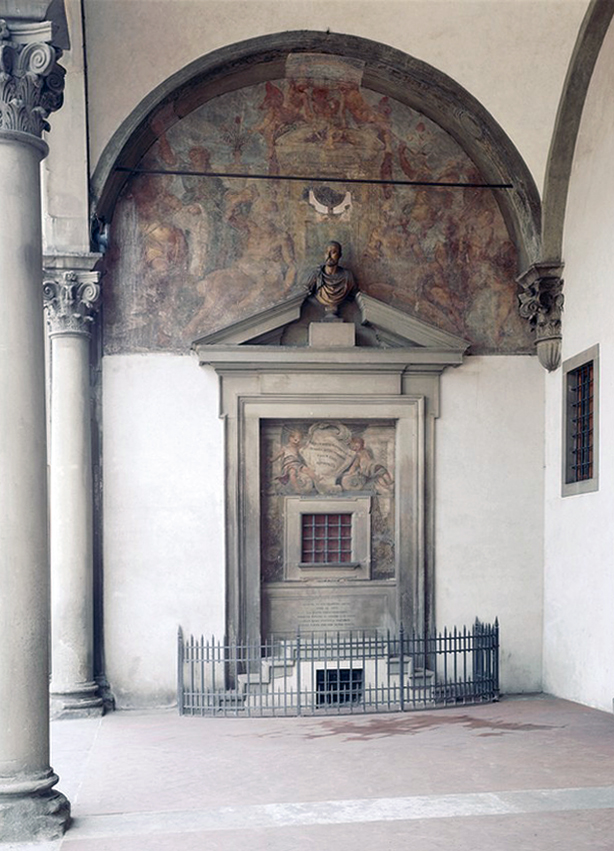
Loggia of the Ospedale degli Innocenti, Florence, with view towards the foundling’s wheel
Designed by the architect Filippo Brunelleschi, the hospital’s loggia served as an important threshold and point of communication with the urban environment. This roofed open-air gallery reveals Brunelleschi’s careful study of ancient Roman architecture. Round arches springing from narrow Corinthian columns break the long façade into regular, repeated units. The symmetry and clarity of the design impose a sense of order on the building, just as they communicate stability in the face of the unpredictable social circumstances that necessitate a foundling hospital.
The loggia also served a practical function in providing a sheltered location, elevated from the street level, where parents could leave their children. Originally, the foundlings were deposited in a pila, a special receptacle similar in appearance to a holy-water font. Starting in the seventeenth century, they were abandoned in the wheel still visible today at the northern end. A revolving-door mechanism allowed parents to leave their children without being seen, although the iron grate limited the size of the foundlings: only small babies could fit through the openings.
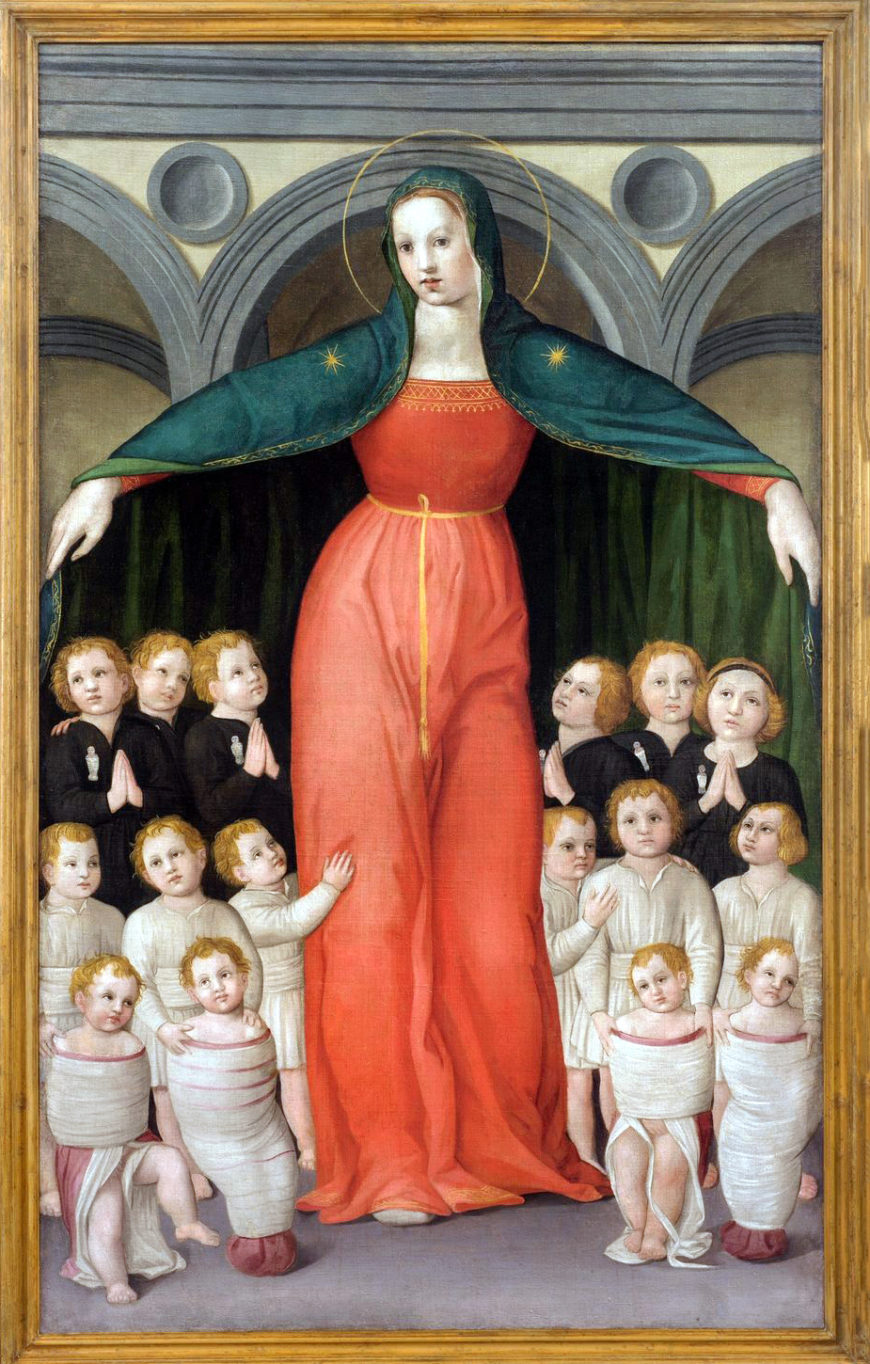
Domenico di Michelino, Madonna of the Innocents, c. 1446, with 16th-century restorations, tempera on canvas, 149 x 90 cm (Museo degli Innocenti, Florence)
Brunelleschi’s design intentionally left the roundels on the loggia facade unadorned, as they appear in an early painting by Domenico di Michelino. The painting, which was probably made to be carried by hospital administrators in public processions, presents an idealized image of the institution. Well-fed and well-behaved foundlings, arranged in rows according to their ages, gather under the mantle of the Virgin Mary, whose protective gesture echoes the physical shelter offered by the building behind her. In 1487, however, Andrea della Robbia was hired to fill the loggia’s roundels with colorful works of art. Described as bambini di terra (“babies made of clay”) in an original payment record, these high-relief sculptures were made in glazed terracotta, a distinctive medium that was the signature of the Della Robbia family workshop.
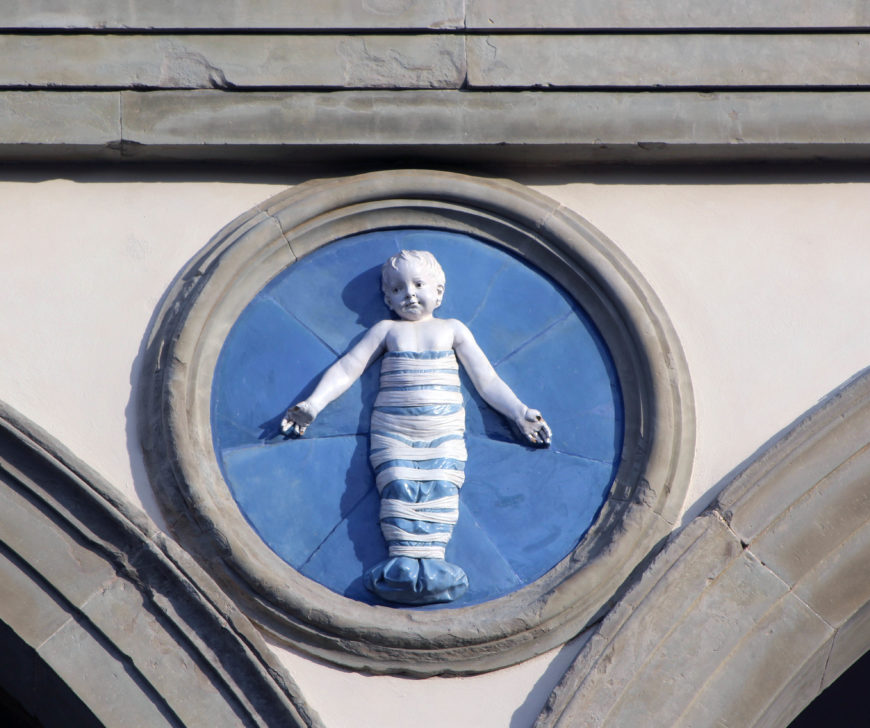
Andrea della Robbia, Infant in Swaddling Clothes, 1487, glazed terracotta, diameter about 100 cm, Ospedale degli Innocenti, Florence (photo: Rachel Boyd)
Glazed terracotta
Andrea’s base materials—clay and ceramic glazes—were prepared according to secret family recipes, which he had learned from his uncle, Luca. He modeled his sculptures with locally sourced clays: the mixture he used was particularly high in calcium, resulting in a buff color (most contemporary potters, by contrast, used clays that were a reddish tone). In the case of the Innocenti roundels, Andrea probably began with a flat slab of clay, carefully measured so that it would fit inside Brunelleschi’s round frames. He then added the high-relief toddlers, using tools to refine the details of their hair, face, and clothes.
After leaving the clay to dry, the sculptures were cut into seven or eight interlocking pieces. Sectioning was a matter of practicality: it made the objects easier to fit into small kilns, and it minimized the chance of warping and other firing defects. Although Andrea was talented at disguising these seams, it was particularly challenging to do so on the flat ground of these roundels, and you can still make out the pie-shaped sections. (It is much more difficult to see where the seams continue across the swaddling bands.)
The sculptures were fired a first time in a very hot kiln, and next they were covered with ceramic glazes, imparting the brightly colored, reflective surfaces we see today. Modern conservation scientists have discovered that Andrea’s glaze mixtures were particularly high in tin and lead oxide, which made them opaque and even. Once the glazes were applied, the sculptures were fired a second time, at a slightly lower temperature. Only at that point were the sculptures ready to be installed.
Installation was a crucial final step, and for this reason, it was often the artist’s responsibility. In fact, we know that Andrea was paid by the hospital for helping to place these sculptures on the loggia. Other Della Robbia sculptures were sent to clients as far away as Sicily and London, and in these cases installation was, by necessity, left to local craftsmen.
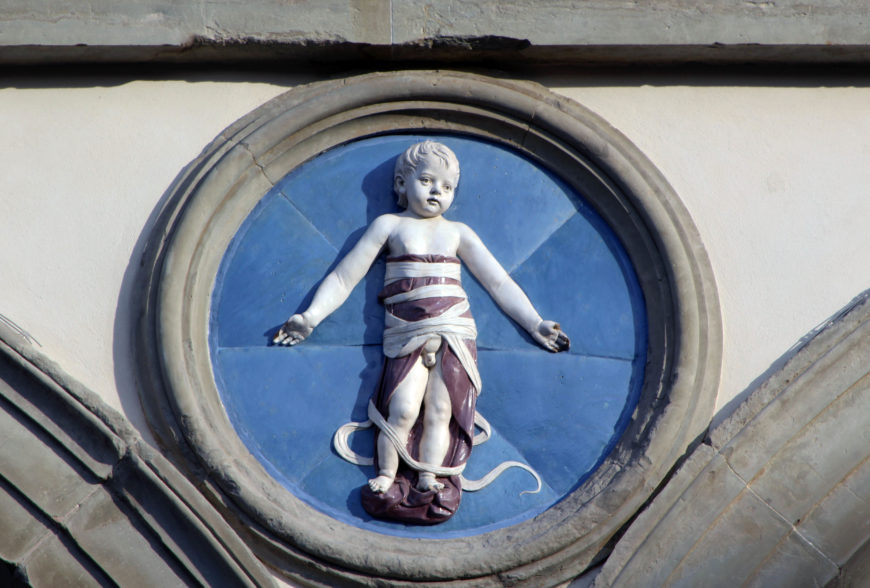
Andrea della Robbia, Infant in Swaddling Clothes, 1487, glazed terracotta, diameter about 100 cm, Ospedale degli Innocenti, Florence (photo: Rachel Boyd)
The Innocenti infants
Their installation in such a prominent location invites the question of what these sculptures were intended to communicate to fifteenth-century viewers. At first glance, their iconography might seem exceedingly clear: perhaps they were meant as simple representations of the young children whom it was the hospital’s mission to care for. If this is so, then their gender and race seem important. After all, the infants with exposed genitalia are male, and they are all covered in the same milky white glaze. Andrea seems to have made no attempt to characterize any of the babies as unmistakably female or of non-white European descent, despite the fact that so many of the children left to the Innocenti fell into these categories.
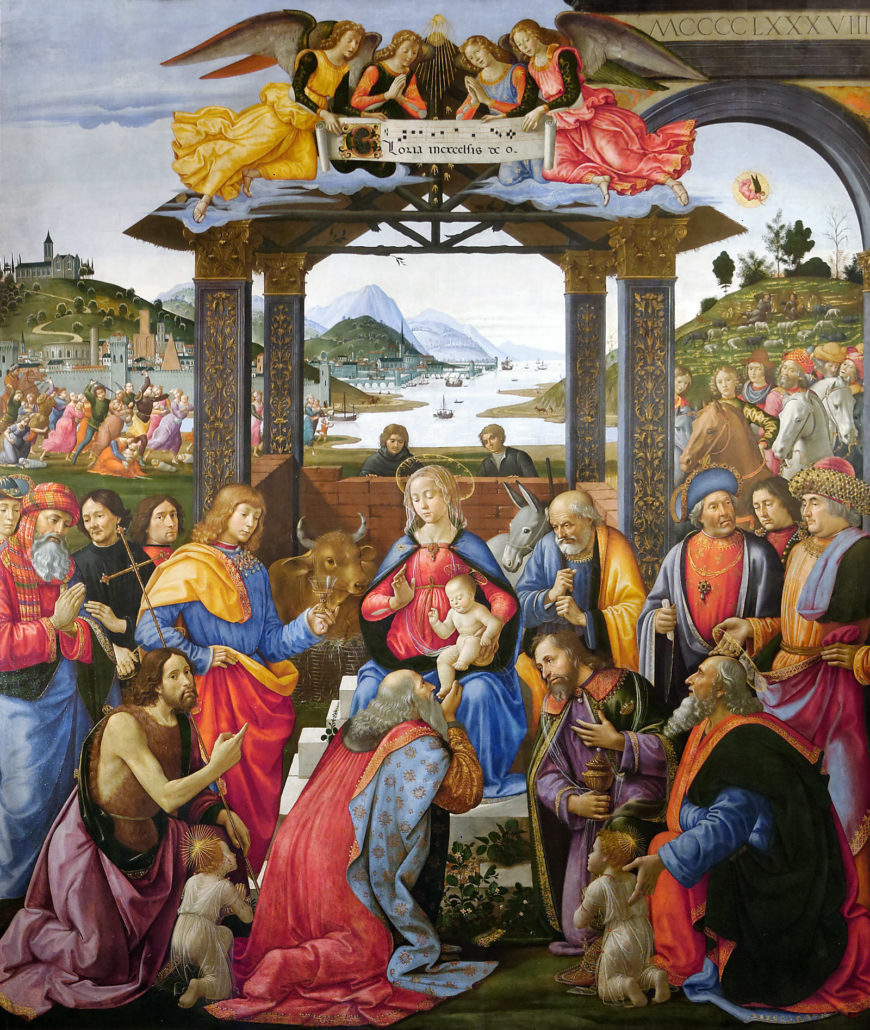
Domenico Ghirlandaio, Adoration of the Magi, 1484–89, tempera on panel, 285 x 240 cm (Museo degli Innocenti, Florence)
Another possibility is that the sculptures depict the young martyrs after whom the hospital was named: the boys killed by Herod during the Massacre of the Innocents (as recounted in the New Testament, in Matthew 2:16–18, Herod the Great, king of Judea, ordered the execution of all male children two years old and under in the vicinity of Bethlehem). These Biblical Innocents were represented in other works of art at the hospital, most prominently in Domenico Ghirlandaio’s Adoration of the Magi, where the massacre can be observed taking place in the left background, and two of the children reappear as kneeling saints in the foreground. Unlike Ghirlandaio’s infants, however, Andrea della Robbia’s apparently healthy babies have no bloody wounds, and they wear practical swaddling bands, not diaphanous gowns.
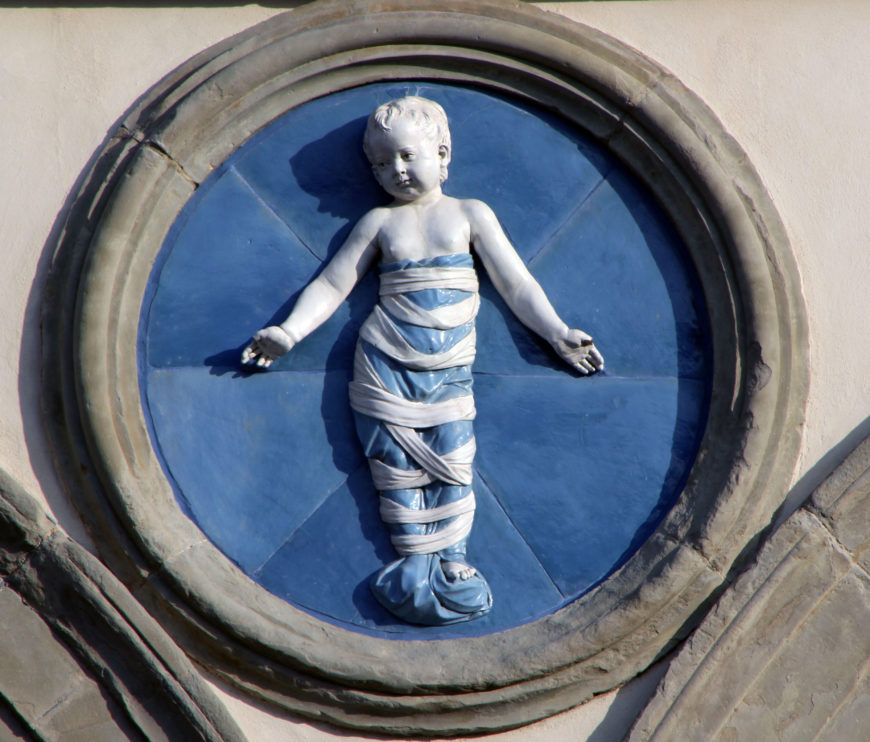
Andrea della Robbia, Infant in Swaddling Clothes, 1487, glazed terracotta, diameter about 100 cm, Ospedale degli Innocenti, Florence (photo: Rachel Boyd)
In the end, the fact that these sculptures defy a simple reading was probably intentional. On one hand, their fleshy bodies and simple costumes are exceedingly human: some have slipped their toes and legs free from their swaddling bands, recalling movements reminiscent of real squirming babies. On the other, the toddlers seem to float inside their abstract blue compartments, and the reflective white glaze elevates them to a semi-divine status.
Perhaps these images proclaimed to the city that the Innocenti valued its children as if they were little saints. Certainly, Andrea’s attention to individual ages, expressions, facial features, and even locks of hair might allude to the variety of bodies and souls cared for in the hospital, even if his images did not reflect the true range. For a host of economic and societal reasons, boys were more desirable than girls in the early modern world, and the idealized images of children that Andrea created—like the playful male babies adorning Renaissance birth trays and church furnishings—reflect this cultural privileging of men. Girls were thought to be weaker and therefore require more care, while boys more perfectly resembled the infant celebrated above all others in Christian cultures: the Christ Child.
Lying-In Hospital (now Brigham and Women’s Hospital), Longwood Avenue, Boston, with roundels that borrow from Andrea’s roundels
The bambini today
In the five centuries since they were installed, the sculptures have become a widely recognized symbol of the Innocenti hospital and of childhood itself. Hospitals and schools across the world are decorated with terracotta, stone, plaster, and mosaic versions of Andrea’s roundels, such as those seen on the façade of the Lying-In Hospital in Boston. An adaptation of one of his bambini even serves as the seal of the American Academy of Pediatrics. Ceramics shops in and around Florence sell Della Robbia imitations to this day, and the continuing life of Andrea’s babies in the modern world testifies to the timeless appeal of his endearing creations.
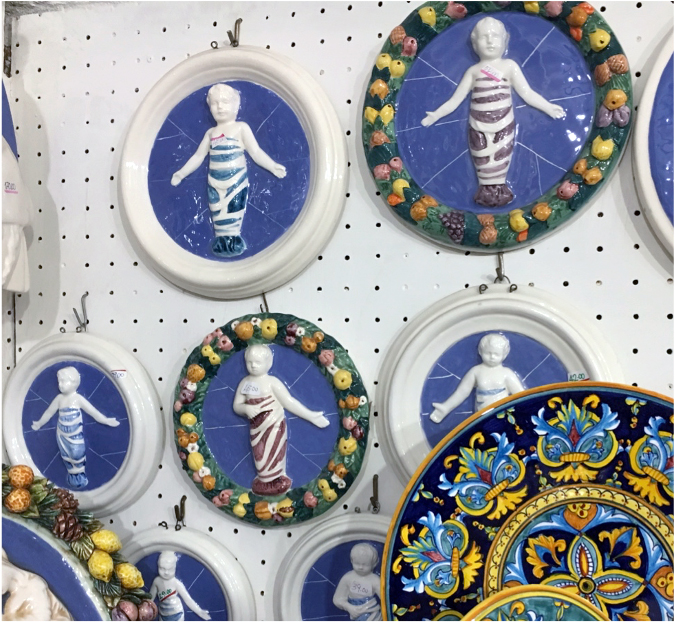
Ceramiche Luca della Robbia, via del Proconsolo, Florence (photo: Rachel Boyd)
Notes:
[1] Philip Gavitt,Charity and Children in Renaissance Florence: The Ospedale degli Innocenti, 1410–1536 (Ann Arbor: The University of Michigan Press, 1990), p. 222.
Additional resources:
Visit the Ospedale degli Innocenti website
Learn more about Renaissance Polychrome Sculpture in Tuscany and specifically these sculptures
Marietta Cambareri, Della Robbia: Sculpting with Color in Renaissance Italy, exhibition catalogue (Boston: MFA Publications, 2016)
Diana Bullen Presciutti, Visual Cultures of Foundling Care in Renaissance Italy (Farnham, Surrey: Ashgate, 2015)

